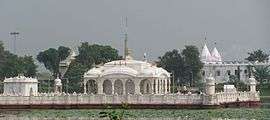Jal Mandir
| Jal Mandir | |
|---|---|
|
Jal Mandir in Pawapuri | |
 Location within Bihar | |
| Basic information | |
| Location | Pawapuri, Nalanda, Bihar, India |
| Geographic coordinates | 25°05′28″N 85°32′19″E / 25.09111°N 85.53861°ECoordinates: 25°05′28″N 85°32′19″E / 25.09111°N 85.53861°E |
| Affiliation | Jainism |
| Deity | Foot prints of Mahavira |
| Festivals | Dipawali |
| Architectural description | |
| Creator | King Nandivardhan |
| Date established | 528 BC |
| Specifications | |
| Temple(s) | 1 |
The Jal Mandir meaning Water Temple, also known as Apapuri,[1] in Pawapuri, meaning a town without sins,[2] in the Indian state of Bihar, is a highly revered temple dedicated to Lord Mahavira, the 24th Thirthankara (religious preacher of Jainism) and founder of Jain religion, which marks the place of his cremation. Mahavira attained Nirvana (salvation) in Pawapuri in 528 BC.[3][4] The temple has been built within a tank filled with red coloured lotus flowers.[5] It is said that the temple was built by King Nandivardhan, Mahavira's elder brother.[6] It is one of the five main temples in Pawpuri, where the "Charan Paduka" or foot impression of Mahavira is deified.[3]
Location
The temple, a famous pilgrimage centre of Jainism, is located in the holy city of Pawapuri in the Nalanda district in the Ganga Basin. It is 108 kilometres (67 mi) away from Patna, the capital city of Bihar which is the nearest airport. Rajgir the nearest railway station is 38 kilometres (24 mi) away,[3][4][7] and 8 miles (13 km) from Biharsharif in the subdivision of the same name. It is at the end of a 1 mile (1.6 km) long branch road from the Patna-Ranchi road.[5][2]
Legend
According to a local legend after Lord Mahavira attained Nirvana at Pavapuri he was cremated in the village. The place of his cremation became a pilgrimage centre when a large number of pilgrims took out a very large amount of soil from the site, which was considered as sacred ashes of Lord Mahavira, and thus created a huge pit which got filled up with water and became a tank. To commemorate the place of his cremation a temple was built within the tank.[3][4][6]
History

Mahavira was a prince of the Magadha Kingdom then known as "Madyama Pawa” or “Apawapuri",[3] Like Buddha, he also became an acetic at the age of 30. During one of the religious observances, called the chaturmas observed by Jains for four months during the rainy season starting from the beginning of the Hindu calendar month of Āṣārh (22 June to 22 July) and ending in the Hindu month of Kartik (October/November), the Jain monks and nuns remain at one holy place and preach the religious teachings of Jainism to the local people. Mahavira also observed this practice and during this period his one such stay was at Pawapuri. On the Dipawali night on the 15th day of the month of Kartik he breathed his last when he was 72 years old. While the place of his death is commemorated by a temple called the "Gaon Mandir" meaning "village temple" (also called "Thal Mandir"), the location where he was cremated, the temple built within a tank is known as the Jal Mandir.[1] There is also another temple here dedicated to Mahavira called "Samosharan" where a statue of Mahavira delivering his last sermon is deified; the temple is circular in shape with beehive shape design.[3]
Features
Jal Mandir, meaning a "temple in water" ,[5] is built in white marble within the water tank; the tank measures 84 bigha (One bigha is 5 acres, area is 16.8 acres).[1] The water surface of the lake is covered with lotuses. This architecturally elegant temple in the form of a "Vimana" or chariot has the footprint of Mahavira for worship. A 600 feet (180 m) long bridge built in stone connects the temple with the bank of the water tank.[3] The temple shines bright and sublime during a moonlit night. The pond has many species of fish which are fed by the priests and devotees.[8]
References
- 1 2 3 Prasad 1995, p. 31.
- 1 2 Choudhury 1956, p. 89.
- 1 2 3 4 5 6 7 "Pawapuri". Officlal website of District Administration of Gaya. Retrieved 15 October 2015.
- 1 2 3 "Pawapuri". National Informatics Centre. Retrieved 15 October 2015.
- 1 2 3 Suriji 2013, p. 23.
- 1 2 "Jal Mandir". Official site of Pawapuri Tirth Organization. Retrieved 15 October 2015.
- ↑ "Jal Mandir WTP1276". Water Resources Information System of India. Retrieved 15 October 2015.
- ↑ Singh 1974, p. 125.
Bibliography
- Choudhury, Pranab Chandra Roy (1956). Jainism in Bihar. I.R. Choudhury.
- Prasad, Jai Ram (1995). Community Strucure [sic] and Political Development: A Case Study of Pyarepur Village. Mittal Publications. ISBN 978-81-7099-601-9.
- Singh, B. N. (1974). Trade and industrial markets of Bihar. Arvind Publications.
- Suriji, Acharya Gunaratna (16 March 2013). A Visit to Shatrunjaya: Journey to the holiest pilgrimage of Jainism. Multy Graphics. ISBN 978-81-926607-0-7.
.jpg)